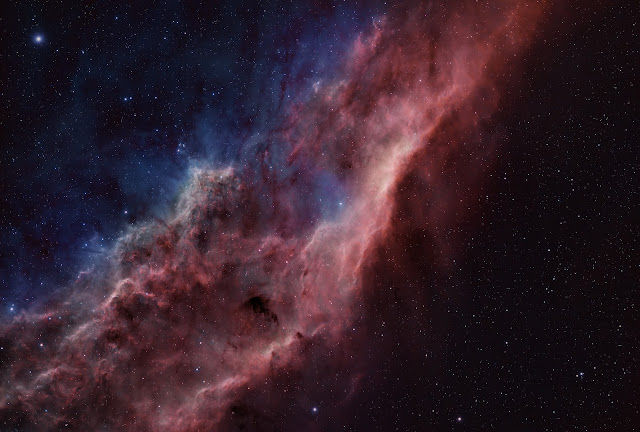A behemoth in galaxy terms M87 or Virgo 1 is a target that a DSLR does not take full advantage of. Especially an imaging set up for wide field. A super giant elliptical that is almost with no dust lanes. A much deeper exposure is required to capture the plasma flow from the galaxies active nucleus.Although it does look like I have captured the inner part closest to the core.What do you think?. Sporting a super massive black hole some 6.6 billion solar masses & larger than our sun -Pluto orbit,it churns out enough X rays, Gamma rays, Radio waves to keep the professional astronomers and orbiting telescopes busy for decades to come.
Just 46 minutes worth of data here. I had problems with the guiding and rejected more than half of the 2 minute guided frames. Darks subtracted and a gradient removal.
Sunday 5 May 2013
The Needle Galaxy
 Known as the Needle Galaxy for its narrow profile, viewed edge on it is probably the most spectacular edge on Galaxy I have seen. I had look visually before I connected the Canon up. A central bulge was very noticeable and the arms just visible in my 90mm. I would love a look soon through our societies 20" http://www.brecklandastro.org.uk/
Known as the Needle Galaxy for its narrow profile, viewed edge on it is probably the most spectacular edge on Galaxy I have seen. I had look visually before I connected the Canon up. A central bulge was very noticeable and the arms just visible in my 90mm. I would love a look soon through our societies 20" http://www.brecklandastro.org.uk/
For set up and framing of an image I usually set the camera to 3200 Iso to capture a faint fuzzy, When I programmed the imaging run I set the Iso to 3200. I have never used such a high setting on a long run of images before. I tried it on M42 but was not happy with the noise and never published the image. I have no stock of 3200 darks either so I thought the run would be a waste of time. Needless to say I was pleasantly surprised with the result. As I mentioned no darks, flats bias frames used. A fine gradient removal was used to even out the image. A visible central bulge and a dust lane gives me the result I was hoping for.
More comet PANSTARRS
A few wonderful clear nights last week has certainly inspired some of the members of http://www.brecklandastro.org.uk/ including myself. With an unfortunate position of a neighbours rooftop I have to wait until midnight to get a glimpse of the now rapidly departing Comet PANSTARRS. Still sporting a lovely fan like tail again I have managed to collect an hours worth of images. I don't know if it's me or Deepsky stacker. I just cannot seem to get the nucleus right. HIP379 looks amazing with a Star Spikes Pro effect.
Subscribe to:
Posts (Atom)
California Nebula
NGC1499 The California Nebula. Discovered in 1889 The California Nebula is an emission nebula in the constellation of Perseus, currently v...

-
Object: M45Type: Open Cluster Distance: 380Light Years (Approx) Constellation: Taurus Date : 27th October 08 Equipment: William Optics M...
-
Without doubt the finest of globular clusters visible in the northern hemisphere. Located outside the plane of our galaxy and some 25,000 li...



